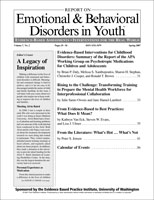Expeditionary Models for At-Risk Youth Are Not Just a “Walk in the Woods”
Author: Eliza Kate Wicks-Arshack.
Source: Volume 15, Number 04, Fall 2015 , pp.87-89(3)

< previous article |next article > |return to table of contents
Abstract:
Although most behavioral problems among teens are addressed in the student’s home and school environments, some cases may involve extreme behavior that cannot be handled in traditional venues. In such cases, behavioral change often requires removing the teen from his or her social environment. If the problematic behavior involves truancy, drug and alcohol use, or other risky behavior, removing the teen from the triggers for these habits and placing them in boarding programs, rehabilitation facilities, or in-patient hospital care are common solutions. Programs that remove the teen entirely from familiar environments and promote self-reflection and renewed socialization have been successful even when other more traditional programs have failed. This article explains the philosophy, the rigor, and the therapeutic value of expeditionary models for helping at-risk teens.Keywords: At-risk teens, behavioral change, expeditionary models, Eagle Rock School and Professional Development Center, Alaska Crossings
Affiliations:
1: Eagle Rock School and Professional Development Center.